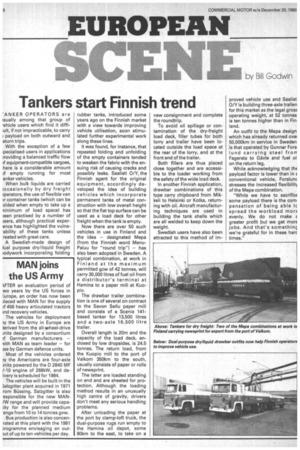Tankers start Finnish trend
Page 38

If you've noticed an error in this article please click here to report it so we can fix it.
.ANKER OPERATORS are isually among that group of rehicle users which find it diffililt, if not impracticable, to carry payload on both outward and eturn trips.
With the exception of a few ;pecialised users in applications goviding a balanced traffic flow A equipment-compatible cargoes, here is a considerable amount A empty running for most anker vehicles.
When bulk liquids are carried )ccasionally by dry freight )perators, the use of flexible van )1container tanks (which can be aided when empty to take up a ninimum of load space) has )een practised by a number of Jsers, although practical experence has highlighted the vulneability of these tanks unless reated with great care.
A Swedish-made design of lual purpose dry/liquid freight )odywork incorporating folding rubber tanks, introduced some years ago on the Finnish market with a view towards improving vehicle utilisation, soon stimulated further experimental work along these lines.
It was found, for instance, that repeated folding and unfolding of the empty containers tended to weaken the fabric with the ensuing risk of causing cracks and possibly leaks. Saalisti 0/V, the Finnish agent for the original equipment, accordingly developed the idea of building vehicles which incorporate permanent tanks of metal construction with low overall height so that the flat top surface can be used as a load deck for other freight when the tank is empty.
Now there are over 50 such vehicles in use in Finland and the idea — designated Mepa (from the Finnish word MenuPaluu for "round trip") — has also been adopted in Sweden. A typical combination, at work in Finland at the maximum permitted gcw of 42 tonnes, will carry 30,000 litres of fuel oil from a distributor's terminal at Hamina to a paper mill at Kuopin.
The drawbar trailer, combination is one of several on contract to the Sayan Sellu paper mill and consists of a Scania 141based tanker for 13,500 litres and a two-axle 16,500 litre trailer.
Overall length is 20m and the capacity of the load deck, enclosed by low dropsides, is 24.5 tonnes. The return load, from the Kuopio mill to the port of Valkom 350km to the south, usually consists of paper or rolls of newsprint.
The latter are loaded standing on end and are sheeted for protection. Although the loading method results in an unusually high centre of gravity, drivers don't meet any serious handling problems.
After unloading the paper at the port by clamp-loft truck, the dual-purpose rugs run empty to the Hamina oil depot, some 80km to the east, to take on a new consignment and complete the roundtrip.
To avoid oil spillage or contamination of the dry-freight load deck, filler tubes for both lorry and trailer have been located outside the load space at the rear of the lorry, and at the front end of the trailer.
Both fillers are thus placed close together and are accessible to the loader working from the safety of the wide load deck.
In another Finnish application, "drawbar combinations of this type carry chipboard from Mikkeli to Helsinki or Kotka, returning with oil. Aircraft manufacturing techniques are used in building the tank shells which are all welded to keep down the weight.
Swedish users have also been attracted to this method of im proved vehicle use and Saalist 0/N1 is building three-axle trailer; for this market as the legal gros5 operating weight, at 52 tonnes is ten tonnes higher than in Fin, land.
An outfit to the Mepa design which has already returned ovei 50,000km in service in Sweden .is that operated by Gunnar Fors lund carrying steel frorr Fagersta to Gavle and fuel oi on the return leg.
While acknowledging that the payload factor is lower than in z conventional vehicle, Forslunc stresses the increased flexibility of the Mepa combination.
"While we have to sacrifice some payload there is the com pensation of being able tc spread the workload more evenly. We do not make greater profit profit but we get more jobs. And that's somethinc. we're grateful for in these harc times."




















































































